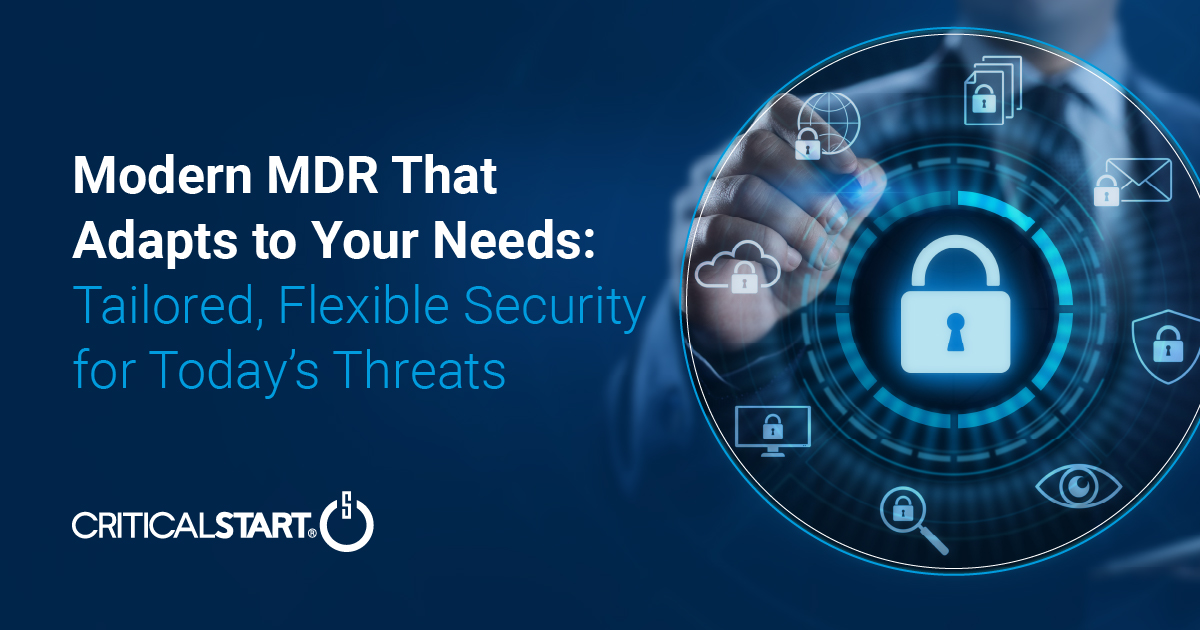Modern MDR That Adapts to Your Needs: Tailored, Flexible Security for Today’s Threats

Every organization faces unique challenges in today’s dynamic threat landscape. Whether you’re managing compliance requirements, hybrid environments, or shifting risk profiles, one thing is certain: a one-size-fits-all approach to cybersecurity doesn’t work.
Legacy Managed Detection and Response (MDR) solutions often rely on rigid service models that can’t keep up with evolving threats or your organization’s needs. The result? Gaps in coverage, inefficiencies, and increased vulnerability to cyberattacks.
Critical Start’s MDR changes the equation by delivering a tailored, flexible approach that adapts to your business — helping you stay secure without compromising agility or performance. Read on to learn how this adaptability translates to real-world results.
Flexibility That Works for You
Modern MDR isn’t just about monitoring threats — it’s about aligning with your business priorities to deliver meaningful, actionable outcomes. Critical Start achieves this through three core pillars:
1. Complete Signal Coverage: Eliminating Blind Spots
Threats thrive in the gaps of traditional MDR. Critical Start’s Complete Signal Coverage (CSC) ensures comprehensive visibility across your IT environment. By monitoring signals from endpoints, SIEM, identity systems, email, cloud workloads, and firewalls, CSC eliminates the blind spots attackers exploit.
What It Means for Your Organization:
- Confidence your infrastructure is covered.
- Faster detection of threats, even in complex hybrid environments.
- Reduced downtime caused by undetected vulnerabilities.
2. Rules of Engagement (ROE): Security Built Around Your Needs
Every organization has unique risks that demand tailored responses. Critical Start’s Rules of Engagement (ROE) are fully customizable, enabling your team to set alert thresholds, escalation paths, and proactive measures that align with your goals. Whether you’re focused on compliance, managing a hybrid workforce, or protecting critical infrastructure, your ROEs evolve with your needs.
What It Means for Your Organization:
- A personalized security strategy that adapts as your business grows.
- Fewer false positive alerts and less alert noise, ensuring your team focuses only on critical threats.
- Confidence that your security operations always align with business priorities.
3. Real-Time Threat Management with MOBILESOC®
Cyber threats don’t follow a 9-to-5 schedule. Critical Start’s MOBILESOC® app empowers your team to manage threats anytime, anywhere. With features like host isolation and account disabling, MOBILESOC® ensures swift containment and resolution, turning potential disruptions into non-events.
What It Means for Your Organization:
- Immediate action during critical incidents, minimizing potential damage.
- Uninterrupted operations, even in hybrid or remote work environments.
- The peace of mind that comes from knowing your team is always in control.
Measurable Outcomes That Matter
Adaptability and flexibility aren’t just buzzwords — they’re the drivers behind real, measurable improvements in security and business outcomes.
Critical Start’s elevated MDR delivers:
- Faster Detection Times: Complete Signal Coverage means every critical signal is monitored, reducing detection delays across your environment.
- Reduced Alert Fatigue: The Trusted Behavior Registry® (TBR®) filters out false positives, allowing your team to focus on genuine threats.
- Seamless Scalability: Vendor-agnostic integrations ensure your security evolves with your organization, supporting transitions to new tools or environments without disruption.
Improved ROI: Tailored service models enhance the value of your existing security investments while reducing overall risk exposure.
Your Future-Proof Security Solution
In a world where cyber threats evolve as fast as technology, rigid MDR solutions simply won’t cut it. Critical Start’s Modern MDR delivers the flexibility, customization, and real-time management your organization needs to stay secure — today and tomorrow.
What Does This Mean for Your Organization?
- A security strategy that evolves alongside your business and threat landscape.
- Tools and expertise that empower your team to act decisively and efficiently.
- The confidence of knowing your organization is always one step ahead of emerging threats.
Adaptability isn’t just an advantage; it’s essential. With Critical Start’s modern MDR, you get a dynamic, proactive solution that keeps you secure and ready for whatever comes next.
Before You Go Seeing is believing. If you’d like to see the unique advantages Critical Start MDR can bring to your organization, get in touch with one of our experts now.
RESOURCE CATEGORIES
- Buyer's Guides(1)
- Consumer Education(39)
- Consumer Stories(2)
- Cybersecurity Consulting(4)
- Data Breaches(15)
- Data Privacy(43)
- Incident Response(2)
- Interview(51)
- MDR Services(59)
- MobileSOC(6)
- News(5)
- Press Release(101)
- Research Report(9)
- Security Assessments(2)
- Thought Leadership(19)
- Threat Hunting(3)
- Video(1)
- Vulnerability Disclosure(1)
